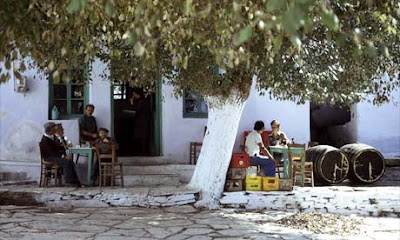"Sounds Greek to me" by Rachel Howard

Think of Greek food and caper croquettes, artichoke frittata, and snail risotto probably don't spring to mind. But Tinos - where these dishes are standard fare - is not like other Greek islands.
Perhaps the food is so good because 90% of visitors are Greeks; the Athenian architects and actors who retreat to their villas in Tinos at weekends won't settle for microwaved moussaka. Most Cycladic islands are too barren for agriculture, but it was obvious that Tinos has a wealth of local produce as soon as we stepped on to the quayside, where farmers were selling marinated caper leaves and necklaces of sun-dried tomatoes from their pick-up trucks.
Only two hours by high-speed ferry from Athens and a 15-minute ride from Mykonos, Tinos has been saved from mass development by the Panagia Evangelistria monastery, one of the holiest sites in Greece. The Greek Orthodox church owns huge swathes of land on the island and has prohibited all but a handful of bars.
We dutifully trudged up the hill to light a candle in the monastery, which loomed above the harbour. Hawkers peddling incense and amulets barely registered the corpulent widows crawling on all fours up the quarter-mile slope to kiss the icon of the Virgin Mary, her beatific features concealed beneath a layer of jewels.
Although the biggest religious festivals are on March 25 and August 15, pilgrims flock to Tinos year round. But these devout day-trippers rarely venture beyond the scruffy port. That means the sandy bays, seaside tavernas, and 50-odd villages lodged in the folds of thyme-scented hills are blissfully crowd-free. Chapels and churches speckle the landscape, their bell towers easily mistaken for the island's trademark dovecotes. These white towers carved with geometric patterns are a legacy of the Venetians, who occupied the island from 1204 until 1715. For centuries, pigeons played a big part in the local economy: their meat was an expensive delicacy and their droppings made top-quality fertiliser.
Another vestige of Venetian rule is the island's Catholic community, centred around Exobourgo, a hunk of rock that overshadows the island's fertile interior. The road weaves through countless quaint hamlets, but we couldn't resist stopping to explore a village called Love, or Agapi in Greek. It is named after Saint Agapitos, whose church is the village centrepiece. Above the doorway was a marble relief of a man carving up a maiden with a cutlass, above the inscription "Agapitus Mars", but the village couldn't have been more peaceful. Oil cans bursting with geraniums were neatly lined up outside lopsided houses that fitted together like a puzzle. Wild fennel fritters, paper-thin slices of louza (smoked pork marinated in wine) and bite-size meatballs were the dishes of the day at the Kafenio tis Kamaras. Everything was homemade - even the crocheted cushions on the terrace, which teetered on the rim of a lush valley.
The neighbouring village of Volax is like a habitat for hobbits. Cottages crouch among smooth round boulders which tumble down the mountain like giant bowling balls. Nobody knows how these peculiar rock formations evolved. Some say there was a volcanic eruption; others claim that meteorites rained down from the sky. The 20th-century Greek philosopher Cornelius Castoriadis simply concluded that Tinos was "not made by human hand".
The colossal rocks around Volax are starting to attract bare-handed bouldering enthusiasts. We opted for a less extreme three-hour hike from the nearby village of Myrsini down to Livada beach. Goats scampered into the woods as we trampled along an ancient footpath shaded by plane trees, following the course of a brook. Then the path forked and we were abruptly transported from The Lord of the Rings to Jurassic Park: a ravine of red-tinged rocks spliced by a stream which dipped and spilled into waterfalls and pools. A bold soul had marked a route of sorts with red dots. We followed them clambering towards the distant speck of sea.
At Livada beach massive breakers battered the rocks, whipped into weird shapes by the north wind. Locals have developed their own Beaufort scale to measure the winds: kapelato will blow your kapelo (hat) off, kareklato will knock you off your karekla (chair), and trapezato will blow over the whole trapezi (table).



Σχόλια
Δημοσίευση σχολίου